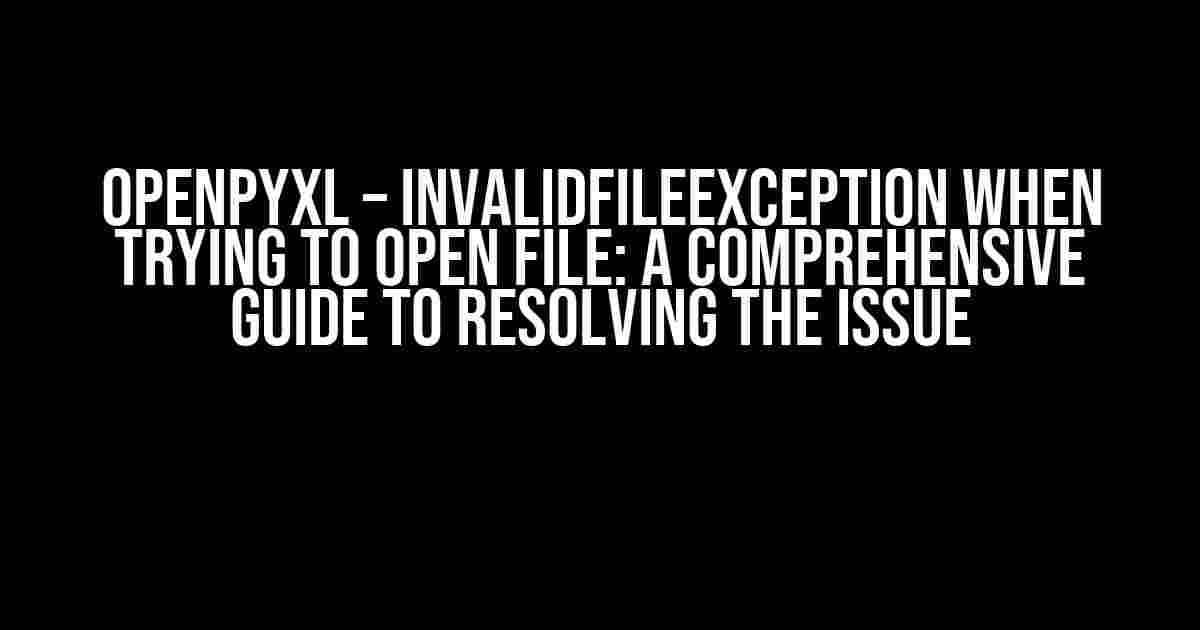Are you tired of encountering the frustrating InvalidFileException error when trying to open a file using OpenPyXL? You’re not alone! This pesky error has plagued many a Python developer, leaving them scratching their heads and wondering what’s going on. Fear not, dear reader, for we’re about to embark on a journey to demystify this error and provide you with a step-by-step guide to resolving it once and for all.
What is the InvalidFileException?
The InvalidFileException is an exception raised by OpenPyXL when it encounters a file that is not a valid Excel file or is corrupted in some way. This exception is thrown when the library attempts to read or write to a file that doesn’t conform to the expected Excel file format.
Common Causes of the InvalidFileException
Before we dive into the solutions, it’s essential to understand the common causes of this error. Here are some of the most common reasons why you might encounter the InvalidFileException:
- Corrupted file: The file you’re trying to open might be damaged or corrupted, preventing OpenPyXL from reading it correctly.
- Incorrect file format: You might be trying to open a file that’s not an Excel file or is in a format that OpenPyXL doesn’t support.
- File not found: The file you’re trying to open might not exist or is not in the location specified.
- Permission issues: You might not have the necessary permissions to read or write to the file.
Resolving the InvalidFileException
Now that we’ve covered the common causes, let’s move on to the solutions! Here are some step-by-step instructions to help you resolve the InvalidFileException:
Verify the File Existence and Permissions
Before we dive into the OpenPyXL-specific solutions, let’s make sure the file exists and you have the necessary permissions to access it. Follow these steps:
- Check if the file exists in the specified location.
- Verify that you have read and write permissions to the file.
- Try opening the file manually to ensure it’s not corrupted.
Check the File Format
Ensure that the file you’re trying to open is a valid Excel file format that OpenPyXL supports. Here are some things to check:
- Is the file a .xlsx, .xlsm, .xltx, or .xltm file?
- Is the file saved in a compatible version of Excel?
- Try opening the file in Microsoft Excel or another spreadsheet program to ensure it’s not corrupted.
Use the load_workbook() function correctly
When using the load_workbook() function, make sure you’re passing the correct file path and format. Here’s an example:
from openpyxl import load_workbook wb = load_workbook(filename='example.xlsx')
In this example, we’re loading an Excel file named “example.xlsx” using the load_workbook() function. Make sure to replace “example.xlsx” with your actual file path and name.
Handle the InvalidFileException using a try-except block
Sometimes, despite your best efforts, the InvalidFileException might still occur. In such cases, you can use a try-except block to catch and handle the exception. Here’s an example:
from openpyxl import load_workbook
try:
wb = load_workbook(filename='example.xlsx')
except FileNotFoundError:
print("The file does not exist.")
except InvalidFileException:
print("The file is not a valid Excel file.")
except Exception as e:
print("An error occurred:", str(e))
In this example, we’re using a try-except block to catch three types of exceptions: FileNotFoundError, InvalidFileException, and a generic Exception. You can customize the error messages and handling to suit your needs.
Additional Troubleshooting Tips
Here are some additional tips to help you troubleshoot the InvalidFileException:
| Troubleshooting Tip | Description |
|---|---|
| Check the file encoding | Ensure that the file is saved in a compatible encoding format, such as UTF-8. |
| Verify the file structure | Check if the file has a valid structure, including a workbook, worksheets, and cells. |
| Try a different file | Test if the issue is specific to the file by trying to open a different Excel file. |
| Update OpenPyXL | Ensure that you’re using the latest version of OpenPyXL, as newer versions might fix bugs and issues. |
Conclusion
In conclusion, the InvalidFileException is a common error that can occur when working with OpenPyXL. By understanding the common causes and following the solutions outlined in this guide, you should be able to resolve the issue and get back to working with your Excel files. Remember to verify the file existence and permissions, check the file format, use the load_workbook() function correctly, and handle the exception using a try-except block. Happy coding!
If you have any further questions or need additional assistance, feel free to ask in the comments below. Don’t forget to share this guide with your fellow developers who might be struggling with the same issue.
Frequently Asked Question
Get ready to conquer the OpenPyXL conundrum! If you’re tired of dealing with the pesky “InvalidFileException” when trying to open a file, you’re in luck!
Why is OpenPyXL throwing an InvalidFileException when I try to open a file?
This error often occurs when OpenPyXL can’t find the file or the file is corrupted. Make sure the file path is correct, and the file is not damaged. Try opening the file manually to ensure it’s not corrupted.
I’m using the correct file path, but I still get the InvalidFileException. What’s going on?
Check if the file is already open in another program. If it is, close it and try again. Also, ensure that the file is a valid Excel file (e.g., .xlsx, .xlsm, .xltx, .xltm) and not a different file type.
I’ve tried everything, but I still get the InvalidFileException. Is there a way to debug this issue?
Yes! You can try using a try-except block to catch the exception and print the error message. This might give you more information about what’s causing the issue. For example: `try: wb = openpyxl.load_workbook(file_path) except InvalidFileException as e: print(e)`. This can help you identify the root cause of the problem.
Can I prevent the InvalidFileException from occurring in the first place?
Yes! You can use the `os` module to check if the file exists before trying to open it with OpenPyXL. For example: `if os.path.exists(file_path): wb = openpyxl.load_workbook(file_path)`. This can help prevent the exception from occurring in the first place.
I’m using OpenPyXL in a web application. What can I do to handle the InvalidFileException when a user uploads a file?
You can use a try-except block to catch the exception and return a user-friendly error message to the user. For example: `try: wb = openpyxl.load_workbook(uploaded_file) except InvalidFileException: return ‘Invalid file uploaded. Please try again.’`. This way, you can provide a better user experience and prevent your application from crashing.



